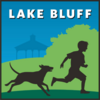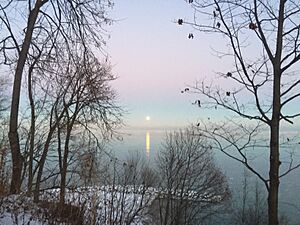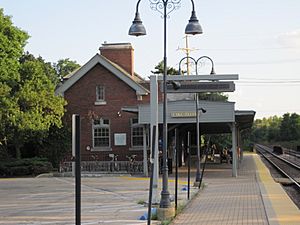Lake Bluff, Illinois facts for kids
Quick facts for kids
Lake Bluff, Illinois
Rockland
|
|||
|---|---|---|---|
| The Village of Lake Bluff | |||
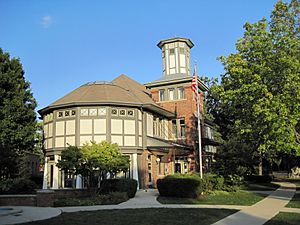
Lake Bluff Village Hall
|
|||
|
|||

Location of Lake Bluff in Lake County, Illinois.
|
|||
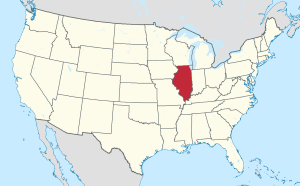
Location of Illinois in the United States
|
|||
| Country | United States | ||
| State | Illinois | ||
| County | Lake | ||
| Township | Shields | ||
| Incorporated | September 21, 1895 | ||
| Government | |||
| • Body | Village Board | ||
| Area | |||
| • Village | 4.09 sq mi (10.58 km2) | ||
| • Land | 4.08 sq mi (10.56 km2) | ||
| • Water | 0.01 sq mi (0.02 km2) | ||
| Lowest elevation | 577 ft (176 m) | ||
| Population
(2020)
|
|||
| • Village | 5,616 | ||
| • Density | 1,377.82/sq mi (531.97/km2) | ||
| • Metro | 8,206 | ||
| Time zone | UTC-6 (CST) | ||
| • Summer (DST) | UTC-5 (CDT) | ||
| ZIP Code(s) |
60044
|
||
| Area codes | Area codes 847 and 224 | ||
| FIPS code | 17-40910 | ||
Lake Bluff (once called Rockland) is a village in Lake County, Illinois, United States. In 2020, about 5,616 people lived there.
Contents
History of Lake Bluff
The first families settled in the Lake Bluff area in 1836. They claimed land from Lake Michigan west to the Green Bay Trail. Some residents even left in 1849 to search for gold in California!
In 1855, the first railroad was built through Lake County. Henry Ostrander owned the land where the train station would be. He said the station could be built there if it was called "Rockland." So, this area, which used to be known as the Dwyer Settlement or Oak Hill, became Rockland. It was the only stop between Highland Park and Waukegan. Rockland had a post office, a general store, a small school, and a church.
From Rockland to Lake Bluff
In 1875, a group of Methodist ministers bought 100 acres of land by the lake. They formed the Lake Bluff Camp Meeting Association. They renamed Rockland to "Lake Bluff." The group wanted to create a resort. This resort would offer religious activities, but also fun social, cultural, and educational programs.
The Camp Meeting quickly became popular. Famous people like Frances Willard and Mrs. Rutherford B. Hayes visited. People came to Lake Bluff in the summer to enjoy the beach and ravines. They also joined in the Camp Meeting activities. A 10-acre lake in the middle of town, called Artesian Lake, offered more fun. Lake Bluff was mostly a summer vacation spot back then.
Land was sold in small plots, and cottages could be built quickly for $250. The first hotel, the Bluff Lodge, opened in 1876. By the mid-1880s, there were over 30 hotels and boarding houses. There was also a large meeting hall that could seat more than 2,000 people.
Becoming a Village
Lake Bluff officially became a village in 1895. Charles Trusdell was the first Village President. The East School opened in September 1895. The current train station was built in 1904, and the Village Hall was built in 1905.
During World War I, Lake Bluff was called the "most patriotic small town in America." This was because residents worked hard to support the Red Cross. They even bought an ambulance to send to France.
In the 1920s, Lake Bluff planned to grow like other towns nearby. New brick stores were added, and the East School got a big addition. But then the Great Depression hit in 1929. Because of this, the plans for growth never happened.
Geography and Nature
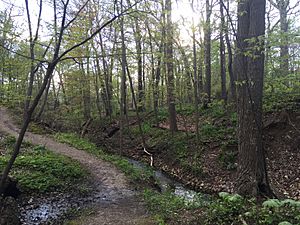
Lake Bluff is located in the North Shore area of Illinois. It is at 42°17′N 87°51′W / 42.283°N 87.850°W.
Lake Bluff covers about 4.09 square miles (10.58 square kilometers). Most of this area is land, with a very small amount of water.
It is next to Lake Michigan on the east. To the north is Naval Station Great Lakes. Lake Forest is to the south, and Libertyville is to the west. The town gets its name from the tall bluff that overlooks Lake Michigan along its eastern edge.
About half of Lake Bluff is residential, meaning people live there. The other half is mostly parks and places for fun activities. Some of the main parks include Blair Park, Ravine Park, Sunrise Park, and Artesian Park.
Population and People
| Historical population | |||
|---|---|---|---|
| Census | Pop. | %± | |
| 1900 | 490 | — | |
| 1910 | 726 | 48.2% | |
| 1920 | 819 | 12.8% | |
| 1930 | 1,452 | 77.3% | |
| 1940 | 1,729 | 19.1% | |
| 1950 | 2,000 | 15.7% | |
| 1960 | 3,494 | 74.7% | |
| 1970 | 5,008 | 43.3% | |
| 1980 | 4,434 | −11.5% | |
| 1990 | 5,513 | 24.3% | |
| 2000 | 6,056 | 9.8% | |
| 2010 | 5,722 | −5.5% | |
| 2020 | 5,616 | −1.9% | |
| U.S. Decennial Census 2010 2020 |
|||
In 2020, Lake Bluff had 5,616 people. Most residents were White (86.20%). About 5.59% were Asian, and 3.67% were of two or more races. About 3.45% of the population was Hispanic or Latino.
In 2010, there were 1,992 households in the village. About 42.5% of these households had children under 18 living with them. The average household had 2.86 people.
The median age in the village was 44.8 years. About 29.3% of the people were under 18 years old.
Getting Around Lake Bluff
Roads
U.S. Route 41 goes through the western part of Lake Bluff. Just west of the village is Interstate 94. Both of these highways help people travel to Chicago or Milwaukee.
Scranton Avenue is like the "Main Street" in the center of town. The local police station, fire department, and Village Hall are on East Center Avenue. Both of these roads go from the center of town to the lake.
Trains
The Union Pacific Railroad (which used to be the Chicago & North Western Railway) still runs through Lake Bluff. This train line is part of Chicago's Metra commuter rail system. It allows people to travel to Chicago's Ogilvie Station. You can also take it north to Kenosha, Wisconsin.
Another train line, the Elgin, Joliet and Eastern Railway, also has tracks in Lake Bluff. This line is for cargo trains, not passengers.
Schools in Lake Bluff
Lake Bluff has public schools for younger students. High school students attend a school in a nearby town.
Public Schools
- Lake Bluff Elementary School (for students in Kindergarten through 5th grade)
- Lake Bluff Middle School (for students in 6th through 8th grade)
- High school students from Lake Bluff go to Lake Forest High School in Lake Forest.
Private School
- Forest Bluff School is a Montessori school for ages 18 months through 8th grade.
Past Schools
Over the years, some schools in Lake Bluff have closed or been replaced:
- Lake Bluff West Elementary School (closed in 1994)
- Lake Bluff Central Elementary School (closed and torn down in 2008)
- Lake Bluff East Elementary School (closed in 2009 and torn down in 2010)
In 2007, people voted to build a new school. The new Lake Bluff Elementary School opened in September 2009. It cost about $20 million. The Lake Bluff Middle School was also updated in 2016. It got new classrooms, a new library, and a Makerspace.
Fun Things to Do
Lake Bluff has many cultural events and traditions!
Annual Events
- The Lake Bluff History Museum sometimes hosts a "Ghost Walk" around Halloween. Residents dress up as ghosts and tell spooky stories about the town's past.
- Every summer, there's a farmers' market every Friday on the Village Green.
- The village also has a Veterans Day flag raising ceremony and a Gazebo lighting around Christmas.
- On July 4th, Lake Bluff has a famous parade. It features many groups and entertainers, including a performance by synchronized lawnmowers!
Famous People from Lake Bluff
Many interesting people have lived in Lake Bluff, including:
- Andrew Bird, a musician
- John H. Bryan, a business leader who helped create Millennium Park in Chicago
- Charlie Finn, an actor
- Richard Marx, a singer-songwriter
- Matt Nagy, a football coach for the Chicago Bears
- John Paxson, a former basketball player and manager for the Chicago Bulls
- Rob Pelinka, the general manager of the NBA's Los Angeles Lakers
- Hadley Richardson, the first wife of famous writer Ernest Hemingway
- Ryne Sandberg, a former baseball player for the Chicago Cubs
- Richard Warren Sears, who founded Sears, Roebuck & Company
Images for kids
See also
 In Spanish: Lake Bluff (Illinois) para niños
In Spanish: Lake Bluff (Illinois) para niños



